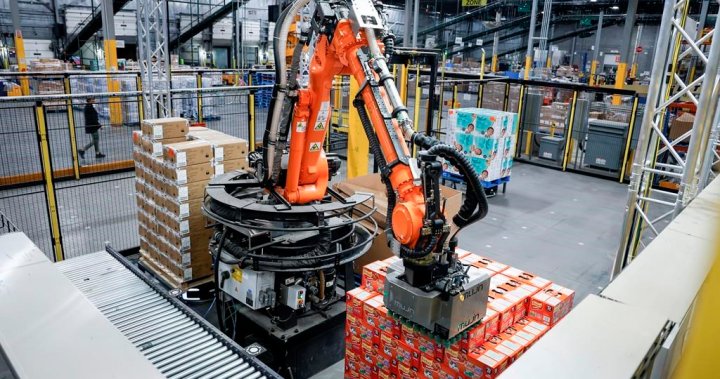In a Calgary warehouse almost as big as eight football fields, an army of robots whir about, carrying massive quantities of merchandise bound for Walmart Canada customers.
Some of the robots zip around the hulking facility transporting pallets of merchandise fresh off delivery trucks. Another resembling a giant arm moves the pallets onto conveyor belts. A third group are labellers.
Together, they shave down the time it takes to get products from trailers into the facility by 90 per cent — and their overlord, Walmart Canada, hopes this is just the start. It plans to bring robots to Mississauga and Cornwall, Ont., distribution centres over the next five years.
“We’re super excited about what we’ve done in Calgary and we’re super excited to scale that and get it into our other sites,” said Matt Kelly, Walmart Canada’s vice-president of supply chain.
It’s not hard to see why companies including Walmart are enamoured with robots.
Robots won’t grumble about tasks and aren’t subject to union or government policies restricting working hours or the heft of the loads they can carry. Though they can have downtime for upgrades, maintenance and recharging, there’s no need to offer them overtime, vacation or benefits.
Kelly’s staff say robots have sped up their ability to throw freight — warehouse lingo for moving merchandise — and boosted safety and ergonomics by reducing repetitive strain and injuries.
“Every associate within our supply chain has the right to go home to their families at the end of the day with no injuries, no cuts, no grazes, no scrapes, nothing more serious,” Kelly said.
Liza Amlani, co-founder of the Retail Strategy Group, sees perks for shoppers too.
Breaking news from Canada and around the world
sent to your email, as it happens.
“Customers today expect a lot more from the brands they buy,” she wrote in an email.
“Implementing the right technology could save the retailer a lot of money which could be passed down as savings to the customer.”
Yet experts have long prophesied the rise of robots puts jobs at risk.
Statistics Canada estimated in 2020 that 10.6 per cent of Canadian workers were at high risk of seeing robots transform their jobs or even replace them in 2016, with 29.1 per cent facing moderate risk.
The risk was even higher for those over 55, without post-secondary credentials or with low literacy and numeracy proficiency.
Kelly maintains Walmart’s robots haven’t nixed the need for workers. In fact, when it announced plans to build the $118 million Calgary distribution centre in 2022, it said the facility would create 325 new jobs.
“We need the human element for oversight and from a safety perspective,” Kelly said.
“What we want our associates to focus on is the problem solving and the critical thinking elements that are always there to run a good, safe supply chain.”
Some companies similarly leaning on robots have even increased their ranks. Statistics Canada found firms that invested in robots between 1996 and 2017 employed more, not fewer, workers.
Businesses already invested in robotics include grocer Sobeys Inc., which runs a Vaughan, Ont., facility where robots deliver bins of merchandise to workers who scoop out the right number of products.
Pizza Hut has also dabbled with autonomous robots to make Vancouver deliveries and RC Coffee robots pump out espressos and lattes in under two minutes in Toronto.
Stratview Research projects rising adoption will push the value of the global retail robotics market to US$105.95 billion by 2029.
Some of that value could be derived from camera-guided drones and smart glasses directing warehouse workers to goods, mused McKinsey & Co. in a 2020 report.
Kelly didn’t say what other innovations are on his radar, but before Walmart implements technologies, it spends months, if not years, rigorously researching and testing devices to ensure they can handle a dizzying array of products.
“(There’s) a lot of different types, shapes, sizes. It comes in different flows,” Kelly said. “It has different temperatures and different regimes that we need to adhere to.”
Even though he insists Walmart doesn’t benchmark its technology to competitors, rivals using robotics loom large.
“Amazon is a great example of being a testing ground for driving efficiencies by leveraging tech,” Amlani said.
“Robots are used in warehouses for restocking and inventory management. Drones are being used for delivery and in-store robots are used for product information and discovery.”
With such competition, complacency isn’t an option for Walmart. The company teased more robots will follow its forthcoming Ontario outfits.
But ask Kelly what technology he dreams of having on hand, he demurs, saying instead “the Holy Grail is that we will continue to innovate.”
“We are always looking for the technologies in the supply chain that will allow our associates to ensure that product is on the shelf at the right time in the right quantities in the right place,” Kelly said.
© 2024 The Canadian Press




